How are SSD drives born? Excursion to the process
Many of us are either already using or thinking about installing SSD disks. But few people know which way they go from a scattered set of parts to beautiful original packaging.
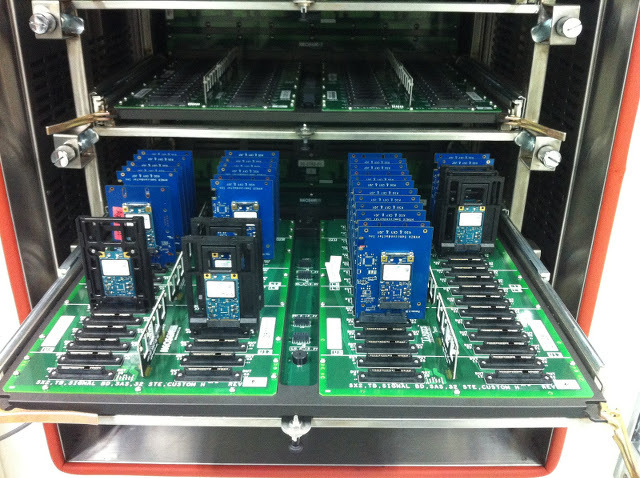
What is the difference between the production of SSD disks and the production of memory modules or, say, flash drives? Pipeline settings and test environments. Boards are made on the same conveyors. Why did I decide to tell about SSD? I just like them.
')
Start this story could be from afar. It could even be very far away - for example, from here:

This is exactly what metallic silicon looks like, which is then smelted in special furnaces, cut into thin disks and made into chips. About this I may still tell you somehow. In the meantime, let us imagine that we have already made the chips, the foiled textolite is prepared, and we can move on.
Textolite sheets are loaded onto the conveyor line manually. Features of conveyors of different manufacturers vary slightly. For some, the line is fully automated; for others, some operations are done manually. For example, A-DATA and some Chinese manufacturers manually perform a visual inspection of almost every board, and at some factory they even manually divide a sheet of PCB into parts after soldering all the parts.
It is necessary to divide it because almost to the end of the line the sheet goes entirely. Billets with pickled tracks, cut openings and marked marks are either manufactured at the factory or ordered from a separate company specializing specifically in the production of such boards. I did not manage to find a high-quality photograph of the blank for SSD drives, so in order to create a rough idea of how it looks, below is a photograph of the blank for RAM modules.

After the preparatory stages, the billet enters the machine, which automatically stenches solder paste, a mixture of small tin particles with a flux (according to Ocelot for clarification). The machine shown below from the Kingston factory looks like a droid from some space saga.
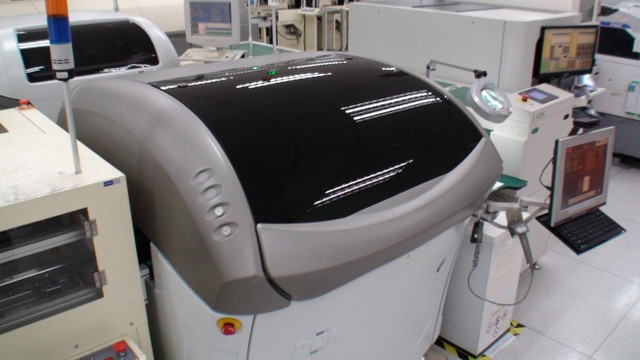
Under the dark glass - a stencil with slits and a large roller with a paste, a grayish viscous mass. From this droid, the billet enters the machine to verify the accuracy of the paste application. The human eye often serves as a part of this apparatus, but it is not complete without computer verification. After application, the workpiece enters the machine that installs the SMT components (from Surface Mounting Technology, surface mount technology). All parts, from the smallest resistors to controllers and memory chips, are fed into the machine by machine-gun belts:
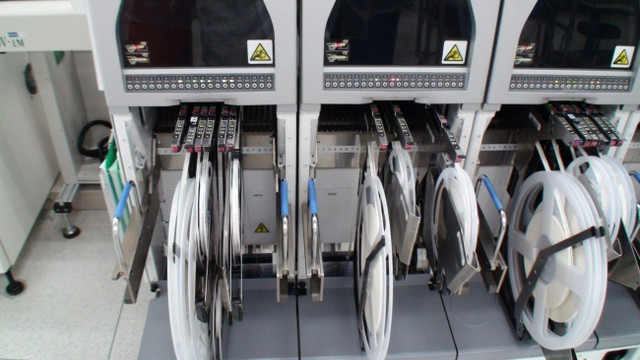
At the exit of the car - another check on the correctness of the placement of parts. Here the ratio of automation / person also varies depending on the plant. The check is passed, and our future disk is ready for baking. Yes, baking. In order not to shoot a laser at each contact for each part, the textolite along with all the details is simply baked.

Depending on the plant, this long process furnace is divided into 7-12 zones, in which the temperature varies from 90-150 degrees at the inlet to 250-280 in the hottest zone closer to the outlet (at the outlet itself, the temperature decreases quite quickly and leaves the furnace already chilled product). Yes, now it can be safely called a product. It is not yet ready for use, but close to it.
After the furnace, special devices make a check on the correctness of the soldering. The computer compares pictures of various areas of the board with sample images, and if a problem is detected, the board is sent for manual verification. In some factories, soldering is also additionally checked in the X-ray range.
After checking the soldering, the products are marked with stickers, by which the manufacturer will be able to track the full history, and finally shared. The testing phase is coming. The first part of it is still on the line. A temporary firmware is automatically loaded into the controller and short primary tests are performed, which take several seconds, and if everything is in order, they are sent to the testing and firmware workshop.
So, Lite-On produces a test for the rate of obsolescence in special heat chambers at elevated temperatures. This allows you to quickly identify defective chips. According to statistics, at this stage only about 0.1% of the lot is rejected. The test lasts from a couple of hours for 64 GB disks to almost a day for 512 GB disks. During the test, a constant read-write is performed in the cells.
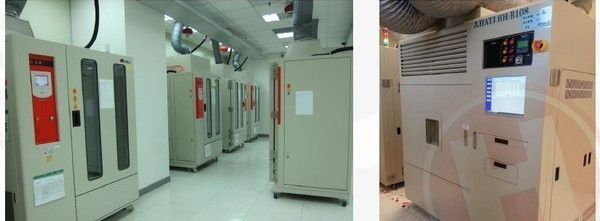
A-DATA testing is not so tough. The disks are connected to special racks in open space, where additional testing, firmware uploading and file system layout are performed.
If we are talking about testing new, newly developed models, they are sure to be checked for compatibility with the majority of modern popular platforms. There are hundreds of laptops alone on the Lite-On test site, and new ones are added every month. In total, there are 85 racks in the laboratory for testing new products, each with 5 test platforms plus one for recording logs.
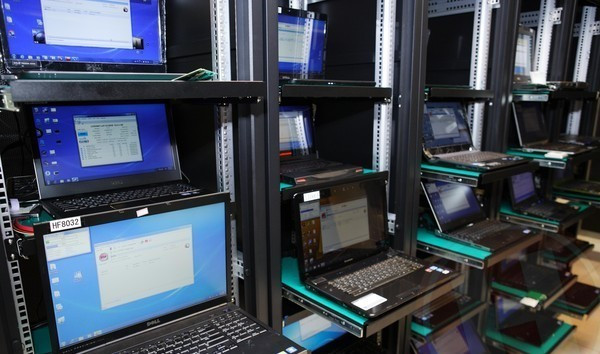
After testing, the products are packaged in cases, glued with branded stickers and packaged. This is mainly done by hand, with fragile Asian handles. Would you like one such tray?
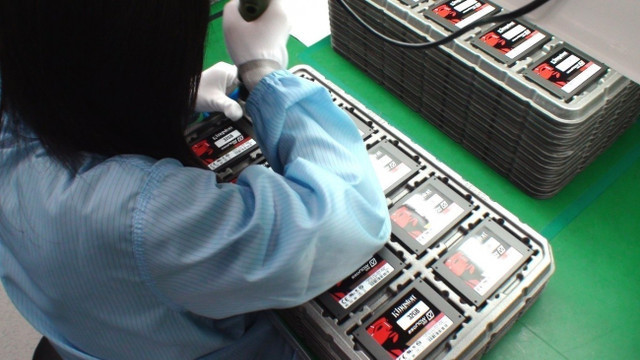
And then everything is simple. The discs are packed in factory boxes and sent to wholesalers. One factory is capable of producing millions or even tens of millions of disks per year. And they are all waiting for their moment when they get into your computers and servers.
In the near future I plan to talk about the different types of memory cells in SSD drives, their advantages and disadvantages. Subscribe to our corporate blog and stay tuned.

What is the difference between the production of SSD disks and the production of memory modules or, say, flash drives? Pipeline settings and test environments. Boards are made on the same conveyors. Why did I decide to tell about SSD? I just like them.
')
Start this story could be from afar. It could even be very far away - for example, from here:

This is exactly what metallic silicon looks like, which is then smelted in special furnaces, cut into thin disks and made into chips. About this I may still tell you somehow. In the meantime, let us imagine that we have already made the chips, the foiled textolite is prepared, and we can move on.
Textolite sheets are loaded onto the conveyor line manually. Features of conveyors of different manufacturers vary slightly. For some, the line is fully automated; for others, some operations are done manually. For example, A-DATA and some Chinese manufacturers manually perform a visual inspection of almost every board, and at some factory they even manually divide a sheet of PCB into parts after soldering all the parts.
It is necessary to divide it because almost to the end of the line the sheet goes entirely. Billets with pickled tracks, cut openings and marked marks are either manufactured at the factory or ordered from a separate company specializing specifically in the production of such boards. I did not manage to find a high-quality photograph of the blank for SSD drives, so in order to create a rough idea of how it looks, below is a photograph of the blank for RAM modules.

After the preparatory stages, the billet enters the machine, which automatically stenches solder paste, a mixture of small tin particles with a flux (according to Ocelot for clarification). The machine shown below from the Kingston factory looks like a droid from some space saga.

Under the dark glass - a stencil with slits and a large roller with a paste, a grayish viscous mass. From this droid, the billet enters the machine to verify the accuracy of the paste application. The human eye often serves as a part of this apparatus, but it is not complete without computer verification. After application, the workpiece enters the machine that installs the SMT components (from Surface Mounting Technology, surface mount technology). All parts, from the smallest resistors to controllers and memory chips, are fed into the machine by machine-gun belts:

At the exit of the car - another check on the correctness of the placement of parts. Here the ratio of automation / person also varies depending on the plant. The check is passed, and our future disk is ready for baking. Yes, baking. In order not to shoot a laser at each contact for each part, the textolite along with all the details is simply baked.

Depending on the plant, this long process furnace is divided into 7-12 zones, in which the temperature varies from 90-150 degrees at the inlet to 250-280 in the hottest zone closer to the outlet (at the outlet itself, the temperature decreases quite quickly and leaves the furnace already chilled product). Yes, now it can be safely called a product. It is not yet ready for use, but close to it.
After the furnace, special devices make a check on the correctness of the soldering. The computer compares pictures of various areas of the board with sample images, and if a problem is detected, the board is sent for manual verification. In some factories, soldering is also additionally checked in the X-ray range.
After checking the soldering, the products are marked with stickers, by which the manufacturer will be able to track the full history, and finally shared. The testing phase is coming. The first part of it is still on the line. A temporary firmware is automatically loaded into the controller and short primary tests are performed, which take several seconds, and if everything is in order, they are sent to the testing and firmware workshop.
So, Lite-On produces a test for the rate of obsolescence in special heat chambers at elevated temperatures. This allows you to quickly identify defective chips. According to statistics, at this stage only about 0.1% of the lot is rejected. The test lasts from a couple of hours for 64 GB disks to almost a day for 512 GB disks. During the test, a constant read-write is performed in the cells.

A-DATA testing is not so tough. The disks are connected to special racks in open space, where additional testing, firmware uploading and file system layout are performed.
If we are talking about testing new, newly developed models, they are sure to be checked for compatibility with the majority of modern popular platforms. There are hundreds of laptops alone on the Lite-On test site, and new ones are added every month. In total, there are 85 racks in the laboratory for testing new products, each with 5 test platforms plus one for recording logs.

After testing, the products are packaged in cases, glued with branded stickers and packaged. This is mainly done by hand, with fragile Asian handles. Would you like one such tray?

And then everything is simple. The discs are packed in factory boxes and sent to wholesalers. One factory is capable of producing millions or even tens of millions of disks per year. And they are all waiting for their moment when they get into your computers and servers.
In the near future I plan to talk about the different types of memory cells in SSD drives, their advantages and disadvantages. Subscribe to our corporate blog and stay tuned.
Source: https://habr.com/ru/post/222023/
All Articles